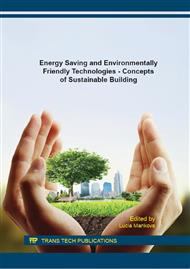p.288
p.299
p.307
p.315
p.323
p.331
p.339
p.347
p.355
The Effect of Thermal Bridges on Energy Balance of Wood Frame Houses
Abstract:
In compliance with the today’s trend of designing sustainable and energy-saving architecture, it is necessary to firstly solve the factors influencing the energy balance. In this respect, the thermal bridges in buildings constitute a crucial factor. In case of their occurrence, the use of construction and insulation building materials is significant for finding the solution. The aim of this paper is to analyse the thermal bridges in buildings constructed on the basis of light constructions. The subject of analysis was an implemented wood frame house with common sandwich construction, designed in a low-energy standard. The house analysis is divided in theoretical and experimental part. The house in question has been directly exposed to dynamic boundary conditions. In order to analyse the thermal bridges, critical details have been selected methodically, verified by thermography. The experimental and theoretical results were compared by the simulation method for calculating critical surface temperatures. Both the measurements and results show how attention shall be paid to this issue at the project stage already. With increasing demands for overall energy balance of buildings, it is necessary to exactly define the critical details and consider the thermal bridges in the project documentation already.
Info:
Periodical:
Pages:
323-330
Citation:
Online since:
January 2016
Authors:
Price:
Сopyright:
© 2016 Trans Tech Publications Ltd. All Rights Reserved
Share:
Citation:



